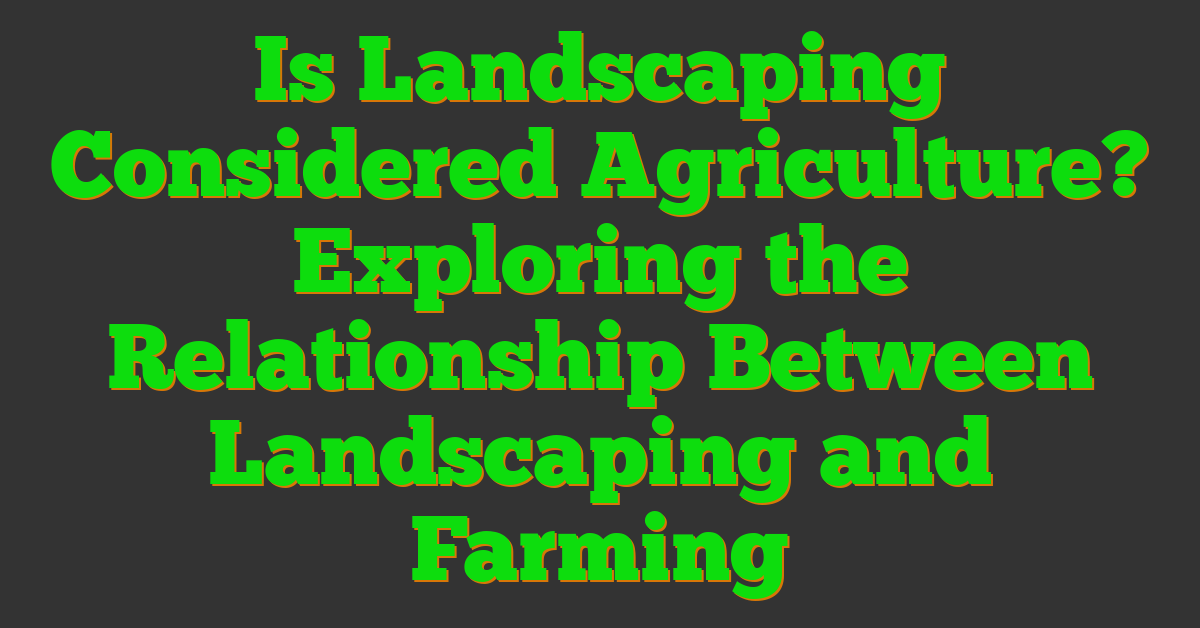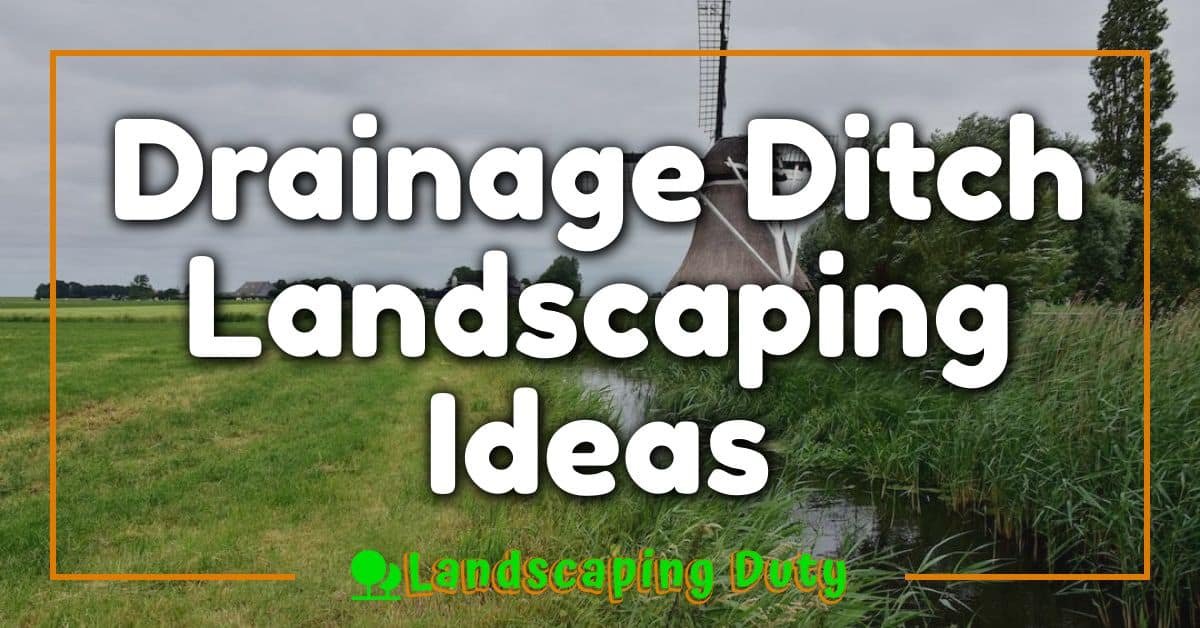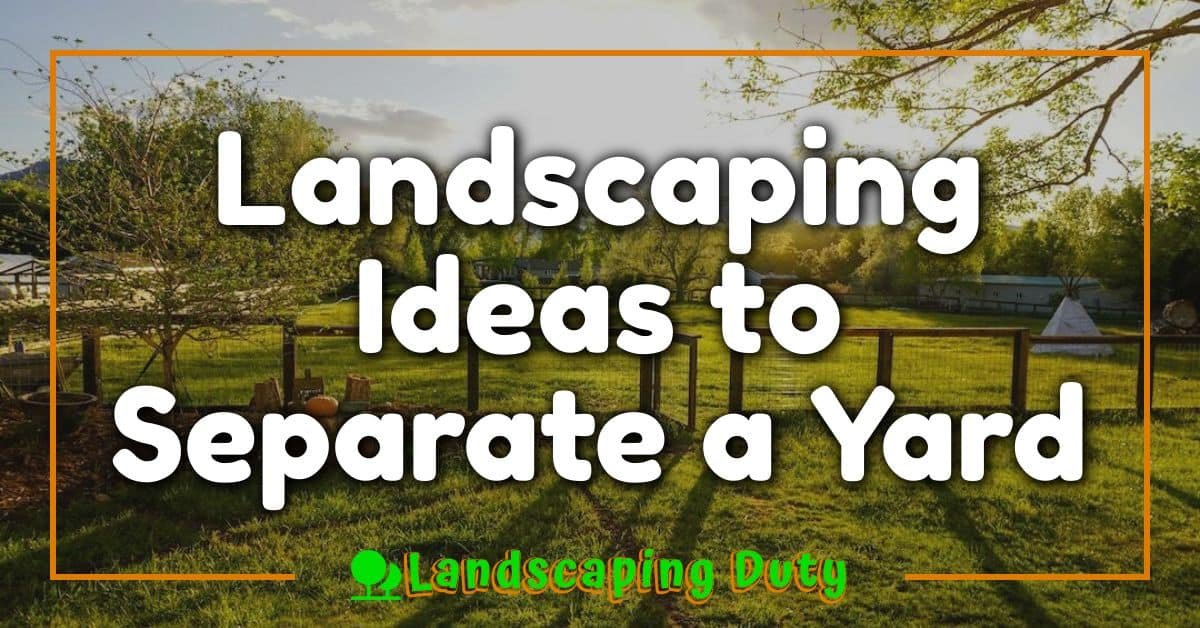If you’re interested in landscaping or agriculture, you may have wondered whether the two are related. Landscaping and agriculture are both practices that involve working with the land, but they have different goals and methods. In this article, we’ll explore the question “is landscaping considered agriculture?” and take a closer look at the similarities and differences between the two.

Defining Landscaping and Agriculture
Before we can answer the question of whether landscaping is considered agriculture, we need to define what we mean by these terms. Landscaping refers to the practice of modifying the visible features of an area of land, which can include planting trees, shrubs, and grasses, as well as building structures such as walls and paths. Agriculture, on the other hand, involves the cultivation of animals, plants, fungi, and other life forms for food, fiber, and other products used to sustain human life. While both landscaping and agriculture involve working with the land, they have different goals and methods.
Key Takeaways
- Landscaping and agriculture are two practices that involve working with the land, but they have different goals and methods.
- Landscaping refers to the practice of modifying the visible features of an area of land, while agriculture involves the cultivation of animals, plants, fungi, and other life forms for food, fiber, and other products used to sustain human life.
- While there are some similarities between landscaping and agriculture, they are generally considered to be distinct practices with different purposes and methods.
Defining Landscaping and Agriculture
https://www.youtube.com/watch?v=638PZqS7H-g&embed=true
What Is Agriculture?
Agriculture is the practice of cultivating land, raising animals, and producing food and other agricultural products. It involves a range of activities such as planting, harvesting, irrigation, and animal husbandry. Agriculture is an essential part of human civilization, and it has been practiced for thousands of years.
Farmers are the backbone of agriculture. They are responsible for growing crops and raising livestock to produce food and other agricultural products. Agricultural products include grains, fruits, vegetables, dairy products, and meat. Farmers use a range of techniques to grow crops and raise animals, including crop rotation, irrigation, and the use of pesticides and fertilizers.
Sustainable agriculture is a growing movement that focuses on producing food and other agricultural products in a way that is environmentally friendly and economically viable. This involves reducing the use of pesticides and fertilizers, promoting crop diversity, and using natural methods to control pests and diseases.
What Is Landscaping?
Landscaping is the practice of designing and modifying land areas to make them more beautiful and functional. This can involve planting trees, shrubs, and flowers, designing walkways and parks, and creating water features. Landscaping can also involve mowing, trimming, and watering lawns.
Landscape architects and designers are responsible for planning and designing landscapes. They work with clients to create beautiful and functional outdoor spaces that meet their needs and preferences. Nurseries and other businesses provide plants and other landscaping materials.
Landscaping is often considered a form of art, and it can have a significant impact on the aesthetic appeal and value of a property. It can also have practical benefits, such as improving the drainage of a property, providing shade, and reducing erosion.
While landscaping and agriculture are distinct practices, there is some overlap between the two. For example, landscaping can involve planting and maintaining gardens, which can produce fruits, vegetables, and herbs. Landscaping can also involve designing and maintaining green roofs, which can provide a range of environmental benefits, such as reducing energy consumption and improving air quality.
Overall, while there are some similarities between landscaping and agriculture, they are distinct practices with different goals and techniques.
Historical Perspectives
https://www.youtube.com/watch?v=h4_7qn32Wvw&embed=true
Evolution of Agriculture
Agriculture has been an essential part of human civilization for thousands of years. It involves the cultivation of land, growing crops, and raising livestock for food, clothing, and other necessities. The earliest form of agriculture was subsistence farming, where people grew crops and raised animals to sustain their families. Domestication of plants and animals led to the development of commercial grain farming, which allowed for surplus production and trade.
Over time, agriculture has become more industrialized, with the use of machinery, fertilizers, and pesticides to increase production. However, this has also led to environmental concerns, such as soil degradation and water pollution.
Development of Landscaping
Landscaping, on the other hand, is the design and maintenance of land areas for aesthetic and functional purposes. It involves the use of plants, hardscapes, and other features to create beautiful and functional outdoor spaces, such as gardens, yards, and parks.
The practice of landscaping has evolved over time, from simple designs to more complex forms that incorporate various elements, such as water gardens and wildlife habitats. Landscaping also provides ecosystem services, such as improving air and water quality and reducing soil erosion.
While there are similarities between agriculture and landscaping, such as the use of plants and the need for proper soil management, they differ in their primary goals. Agriculture is primarily focused on production, while landscaping is focused on creating beautiful and functional outdoor spaces.
« What Are Landscape Elements: A Simple Guide What Are the Elements of Landscaping? A Beginner’s Guide »
In conclusion, while agriculture and landscaping share some similarities, they are distinct practices with different goals and purposes. Understanding the historical evolution of both practices can help us appreciate their importance and value.
Economic and Environmental Impact
https://www.youtube.com/watch?v=bi2xeMQsGQ4&embed=true
Agriculture’s Role in the Economy
Agriculture plays a significant role in the economy. The production of agricultural products such as milk, meat, eggs, wood, and raw materials contributes to the overall growth of the economy. According to Choices Magazine, major land-use changes have occurred in the United States during the past 25 years. The total area of cropland decreased by 58 million acres, while the area of forestland increased by 36 million acres. These changes have had significant impacts on the economy.
Profit is an important aspect of commercial and industrial agriculture. The production of agricultural products is a business that generates income for farmers and other stakeholders. The agricultural industry provides jobs for millions of people, and it contributes to the overall growth of the economy.
Landscaping’s Contribution to Environment
Landscaping is a form of agriculture that involves the design, installation, and maintenance of outdoor spaces. Landscaping contributes to the environment in various ways. It provides ecosystem services such as pollination, pest management, water retention, and nutrient supply. Landscaping also helps to reduce pollution and improve water health.
According to Citizen Sustainable, landscaping can be used to create sustainable outdoor spaces that benefit the environment. For example, planting trees and shrubs can help to reduce air pollution and improve the quality of the air we breathe. Landscaping can also help to reduce water pollution by reducing runoff and improving water quality.
In conclusion, agriculture and landscaping play important roles in the economy and the environment. While commercial and industrial agriculture is focused on profit, landscaping is focused on creating sustainable outdoor spaces that benefit the environment. By understanding the economic and environmental impacts of agriculture and landscaping, you can make informed decisions about the products you buy and the services you use.
Practical Aspects of Agriculture and Landscaping
https://www.youtube.com/watch?v=YEipDObccTo&embed=true
Cultivation and Planting Techniques
When it comes to agriculture and landscaping, cultivation and planting techniques are crucial. The type of soil, crops, vegetables, fruits, and flowers that you choose to plant can have a significant impact on the success of your project. Proper irrigation is also important to ensure that your plants receive enough water to grow and thrive.
It’s essential to choose the right pesticides, herbicides, and fertilizers to protect your plants from pests and keep them healthy. However, it’s important to use these chemicals responsibly to avoid harming the environment and other living organisms.
Design and Maintenance of Land
Designing and maintaining your land is another critical aspect of agriculture and landscaping. When planning your project, consider the size and shape of your land, as well as any walkways or irrigation systems that you may need to install.
Mowing and trimming your lawn regularly is essential to keep it looking neat and tidy. You may also need to construct structures such as retaining walls or garden beds to help control erosion and create a more visually appealing landscape.
Proper planning and designing can help ensure that your land is both functional and visually appealing. Regular watering and maintenance can help keep your plants healthy and thriving.
Overall, agriculture and landscaping require careful planning, attention to detail, and a commitment to responsible environmental stewardship. By choosing the right techniques and materials, you can create a beautiful and sustainable landscape that will provide enjoyment for years to come.
Legal and Regulatory Considerations
https://www.youtube.com/watch?v=trDNKqqWEEA&embed=true
When it comes to landscaping, there are certain legal and regulatory considerations that you need to keep in mind. This section will cover some of the most important ones, including agricultural law and policies and landscaping regulations.
Agricultural Law and Policies
Agricultural law and policies are an important consideration when it comes to landscaping. This is because certain landscaping activities may be considered agricultural activities, which means that they are subject to specific laws and regulations. For example, the planting of trees and bushes may be considered an agricultural activity if it is part of the production, cultivation, growing, and harvesting of agricultural or horticultural commodities. Similarly, if you are a farmer or perform landscaping activities on a farm as an incident to or in conjunction with farming operations, you may be subject to agricultural laws and policies.
One of the key benefits of complying with agricultural laws and policies is that it can help you mitigate risk. By following established guidelines and regulations, you can minimize the chances of environmental problems arising from your landscaping activities. Additionally, compliance with agricultural laws and policies can help you avoid legal issues that may arise from non-compliance.
Landscaping Regulations
In addition to agricultural laws and policies, there are also specific regulations that apply to landscaping activities. These regulations are designed to protect the environment and ensure that landscaping activities do not cause harm to the surrounding land areas.
One of the most important regulations to be aware of is the requirement to obtain permits for certain landscaping activities. For example, if you are planning to undertake a major landscaping project that involves significant changes to the terrain, you may need to obtain a permit from your local government. Similarly, if you are providing landscape architectural services, you may be subject to specific regulations that govern your activities.
Another important consideration when it comes to landscaping regulations is the need to comply with environmental regulations. This may include regulations related to the use of pesticides, fertilizers, and other chemicals in your landscaping activities. By following established guidelines and regulations, you can ensure that your landscaping activities are sustainable and do not cause harm to the environment.
Overall, it is important to be aware of the legal and regulatory considerations that apply to landscaping activities. By complying with these laws and regulations, you can ensure that your landscaping activities are sustainable, minimize risk, and avoid legal issues.
Cultural and Social Dimensions
https://www.youtube.com/watch?v=sFcSqC_jpXE&embed=true
Agriculture in Society
Agriculture has been an integral part of human society for thousands of years, providing food, fiber, and fuel to communities around the world. The production of food is essential to human survival, and farming has been a crucial aspect of food production. Farmers have played an essential role in shaping the culture and economy of societies throughout history.
In subsistence farming, farmers produce food primarily for their families and communities. In contrast, commercial farming produces food for sale and distribution. While commercial farming has become more industrialized in recent years, small-scale farming and hobby farming are still prevalent in many rural areas.
Landscaping in Urban and Rural Settings
Landscaping is the process of modifying an area of land to enhance its aesthetics, functionality, and overall appeal. Landscaping can be done in both urban and rural settings and can include a variety of elements such as gardens, yards, parks, and nurseries.
In urban areas, landscaping is often used to beautify public spaces and improve the quality of life for residents. In contrast, landscaping in rural areas is often focused on ranching and agriculture, with farmers and ranchers modifying the land to support their livestock and crops.
While landscaping and agriculture share some similarities, they are distinct practices. Landscaping is primarily concerned with the aesthetic and functional aspects of an area of land, while agriculture is focused on the production of food and other agricultural products.
In conclusion, while landscaping and agriculture share some similarities, they are distinct practices with different goals and objectives. Both practices are essential to human society, providing food, beauty, and functionality to communities around the world.
Technological Innovations
Advancements in farming technology have made it possible for farmers to increase their crop yields while minimizing their use of resources. Modern farming equipment, such as tractors and plows, have made it easier for farmers to cultivate their land and prepare it for planting. The use of precision farming equipment driven by GPS technology has also enabled farmers to optimize their use of water and fertilizer, resulting in higher crop yields and reduced environmental impact.
Advancements in Farming
In addition to equipment, advancements in breeding and agronomy have also contributed to sustainable agriculture. Modern breeding techniques have allowed farmers to develop crops that are more resistant to pests and diseases, reducing the need for harmful pesticides and herbicides. Agronomy has also played a crucial role in sustainable agriculture by helping farmers to optimize their use of water and nutrients.
Modern Landscaping Techniques
Similarly, technological innovations have also transformed the landscaping industry. The use of modern equipment and design techniques has made it possible for landscapers to create beautiful outdoor spaces while minimizing their environmental impact. Landscape architectural services now incorporate sustainable design principles into their planning, resulting in landscapes that are not only aesthetically pleasing but also environmentally friendly.
In conclusion, technological innovations have played a crucial role in both agriculture and landscaping. Advancements in equipment, breeding, agronomy, and design have made it possible for farmers and landscapers to create sustainable outdoor spaces that are both beautiful and environmentally friendly.
Frequently Asked Questions
https://www.youtube.com/watch?v=g1bwkomXOZs&embed=true
How does horticulture relate to landscaping and agriculture?
Horticulture is the science and art of cultivating plants. It is a branch of agriculture that deals with the growing of fruits, vegetables, flowers, and ornamental plants. Landscaping, on the other hand, is the practice of designing, installing, and maintaining outdoor spaces. While horticulture and landscaping are related, they are not the same thing. Landscaping can include horticultural practices, such as planting and maintaining gardens, but it also involves other activities like installing hardscapes, irrigation systems, and outdoor lighting.
What activities are included in the landscaping industry in Florida?
In Florida, the landscaping industry includes a wide range of activities, such as planting, pruning, mowing, fertilizing, and pest control. Landscapers also install and maintain irrigation systems, outdoor lighting, and hardscapes like patios, walkways, and retaining walls. Additionally, some Florida landscapers provide design services to help clients create a custom outdoor space that meets their needs and preferences.
Can you explain the difference between landscaping and general agriculture?
While both landscaping and agriculture involve working with plants, there are some key differences between the two. Agriculture is the practice of cultivating crops or raising livestock for food, fiber, or other products. It involves large-scale farming operations and is usually done for commercial purposes. Landscaping, on the other hand, is focused on creating and maintaining outdoor spaces for aesthetic and functional purposes. It can involve planting and maintaining gardens, but it also includes other activities like installing hardscapes, outdoor lighting, and irrigation systems.
Is gardening considered a form of agriculture, and if so, how?
Gardening can be considered a form of agriculture, but it depends on the scale and purpose of the activity. If you are growing fruits, vegetables, or herbs for personal consumption, then it is considered gardening. However, if you are growing these crops for commercial purposes, then it is considered agriculture. Gardening can also be considered a form of horticulture, which is the science and art of cultivating plants.
What are the various categories within the field of agriculture that landscaping might fall under?
Landscaping can fall under several categories within the field of agriculture, including horticulture, agronomy, and environmental science. Horticulture involves the cultivation of plants, while agronomy focuses on crop production and soil management. Environmental science deals with the impact of human activities on the environment and includes topics like conservation, restoration, and sustainability. Landscaping can also involve knowledge of irrigation systems, pest control, and plant nutrition.
How is a landscape defined within the context of agricultural practices?
A landscape, within the context of agricultural practices, refers to the visible features of an area of land that have been modified or designed for a specific purpose. This can include planting crops, creating gardens, installing hardscapes, and managing natural resources like water and soil. The goal of agricultural landscaping is to create a functional and aesthetically pleasing outdoor space that is sustainable and productive.












